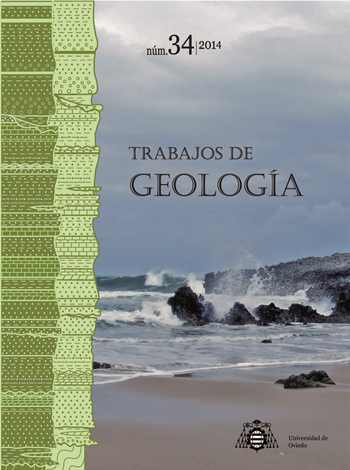Resumen
Resumen: Se discute el origen, evolución, relaciones y variabilidad ornamental intra-específica de los géneros estrofodóntidos de Europa occidental y N de África, Beethovenia n. g. y Plicostropheodonta Sokolskaya, 1960. Se describen y figuran las especies cantábricas Beethovenia bachi n. sp., del Praguiense inferior, Plicostropheodonta crassicosta n. sp., del Emsiense inferior, P. latronensis n. sp. y B. beethoveni n. sp., de la parte inferior del Emsiense superior y B. brahmsi n. sp. y P. diffusa (D. & P. Oehlert, 1896), de la parte superior del Emsiense superior, de la que se aportan nuevos datos sobre localidad y estratotipo en el área de Ferroñes. B. bachi n. sp. debió proceder de la especie cantábrica Fascistropheodonta primaeva García-Alcalde, la más antigua del género, del Lochkoviense más alto o Praguiense más bajo, y originaría, a su vez, durante el Praguiense, formas plicostrofeodontoides próximas a B. acutiplicata (Oehlert y Davoust, 1879). De algún antecesor de estas formas, surgieron, a su vez, los tipos morfológicos principales de Plicostropheodonta: el representado por la especie-tipo, P. murchisoni (Verneuil y d’Archiac en d’Archiac y Verneuil, 1842), del Praguiense de Alemania, con pliegues radiales tendiendo a debilitarse y desaparecer hacia el margen de la concha, y el de la forma cantábrica P. crassicosta n. sp. con la tendencia contraria, es decir, con pliegues radiales haciéndose más fuertes distalmente. El origen y relaciones de las formas cantábricas B. beethoveni n. sp., especie-tipo del nuevo género y B. brahmsi n. sp., y B. ? steiningeri (Drevermann, 1907), del Emsiense superior del Macizo Esquistoso Renano de Alemania y, tal vez, de Bélgica, no está claro aún. En cualquier caso, muchas pequeñas formas plicostrofeodontoides-fascistrofeodontoides del Praguiense y Emsiense del dominio paleogeográfico del Viejo Mundo, asignadas habitualmente a P. murchisoni, en Bélgica, Francia, Pirineos, Zona Centroibérica, Portugal y N de África, deben de pertenecer, más bien, a alguna de las especies citadas de Beethovenia o a otras aún no descritas del mismo género. P. crassicosta n. sp. fue, a su vez, la antecesora de P. latronensis n. sp. y ésta, probablemente, de P. diffusa (D. & P. Oehlert, 1896), en el Emsiense superior. Beethovenia y Plicostropheodonta evolucionaron de manera paralela a lo largo del Praguiense-Emsiense, con aumento progresivo del tamaño y grosor de las paredes de la concha, fortalecimiento de las estructuras internas y pérdida del carácter plicostrofeodontoide puro de la ornamentación radial que se manifiesta en los orígenes de ambos taxones. Ambos géneros se extinguieron, sin dejar descendencia, antes de comenzar el Devónico Medio.
Palabras clave: Beethovenia n. gen., Plicostropheodonta, evolución, taxonomía, Europa occidental, N África, Zona Cantábrica (España).
Abstract: The origin, evolution, relationships and intra-specific ornament variability in the Western Europe and North Africa strophodontid Beethovenia n. gen. and Plicostropheodonta Sokolskaya, 1960 are discussed. The Cantabrian (N Spain) species Beethovenia bachi n. sp., from the lower Pragian, Plicostropheodonta crassicosta n. sp., from the lower Emsian, P. latronensis n. sp. and B. beethoveni n. sp., from the lower part of the upper Emsian, and B. brahmsi n. sp. and P. diffusa (D. & P. Oehlert, 1896), from the upper part of the upper Emsian, are described and figured. New data concerning to the P. diffusa locus and stratum typicum in the Ferroñes area are given. B. bachi n. sp. must originate from the Asturian Fascistropheodonta primaeva García-Alcalde, 1992, the oldest Fascistropheodonta species, from the uppermost Lochkovian or lowermost Pragian. In turn, B. bachi could be the predecessor along the Pragian of plicostropheodontoid forms close to B. acutiplicata (Oehlert y Davoust, 1879). From the same lineage probably sprung off along the Pragian-lower Emsian interval the main Plicostropheodonta morphological lineages. These lineages are represented on the one hand by the type-species, P. murchisoni (Verneuil y d’Archiac en d’Archiac y Verneuil, 1842), from the Pragian of Germany, with plicostropheodontoid radial folds weakening and losing near the shell margins, and on the other by the lower Emsian Cantabrian form P. crassicosta n. sp. trending to the opposite side, i. e., with plicostropheodontoid radial ornamentation strengthening distally. The affinities between both the Cantabrian forms B. beethoveni n. sp., the type-species of the new genus, and B. brahmsi n. sp., and the German (and maybe Belgian) species B. ? steiningeri (Drevermann, 1907), are not yet clear. Anyway, many small plicostropheodontoid-fascistropheodontoid Pragian and Emsian forms from the Old World paleogeographic domain (Belgium, France, Pyrenees, Central-Iberian Zone, Portugal and North Africa), usually identified as Plicostropheodonta murchisoni, could belong rather to some of the described Beethovenia species or to other not yet described from the same genus. P. crassicosta n. sp. evolved near the lower/upper Emsian boundary, P. latronensis n. sp., and from this latter P. diffusa (D. & P. Oehlert, 1896) at the upper part of the upper Emsian. Beethovenia and Plicostropheodonta evolved rather parallely along the Pragian-Emsian times, by increasing the shell size and solidity, strengthening the internal structures and losing the net plicostropheodontoid radial ornamentation characterizing both taxa beginnings, and became extinct with no descent before the Middle Devonian.
Keywords: Beethovenia n. gen., Plicostropheodonta, evolution, taxonomy, Western Europe, N Africa, Cantabrian Zone (Spain).
